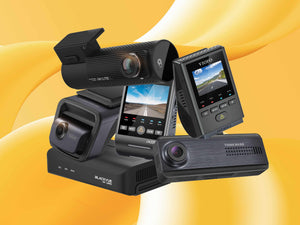- Using the glass cleaner and microfibre cloth, clean the interior and exterior of the rear windshield. A clean windshield promotes a stronger adhesion between the adhesive and the glass, and clearer view.
2. Remove the plastic covering from the rear camera's adhesive pad and the plastic covering off the lens.
3. Securely press the rear camera to the rear windshield to mount. Ensure the lens itself is centered on the windshield, and not the camera's body.
4. Ensure it's aligned properly and won't obstruct your view. Adjust the camera angle so the vehicle's hood takes up 1/4 - 1/8 of the screen. While rear cameras lack a screen, we recommend using the dash cam's smartphone app for live viewing. If your camera does not have an app, use the physical screen of the front unit for this. Many models also have positioning lines in their live-view to help with optimal positioning.
5. Next, the wires. You should connect the rear camera cable to the front camera through the longer rear cable that comes in the package. Route the rear cable along the headliner, past the car pillars on the passenger side. Just be cautious and patient to avoid damaging anything. After you finish your work, you'll put the headliner back up by reversing the steps you took to remove it. It might sound a bit tricky, but with the right tools and some care, it can be done!
6. Conceal the cable along the car's interior edges to keep it out of sight. Using a Trim Tool or other device to get in there can be helpful. If your dash cam has slim coaxial cables, it will surely be a breeze too. Ensure that there are no kinks, creases, or hard angles in the cable, which could interrupt the connection of the cable. Even if the system works initially, it’s best to avoid these to prevent issues down the line, as your car jostles from place to place along your day-to-day.
7. Lastly, test the rear camera. After connecting the power, turn on the camera and ensure it's recording correctly. Adjust the angle if necessary to ensure optimal coverage.

